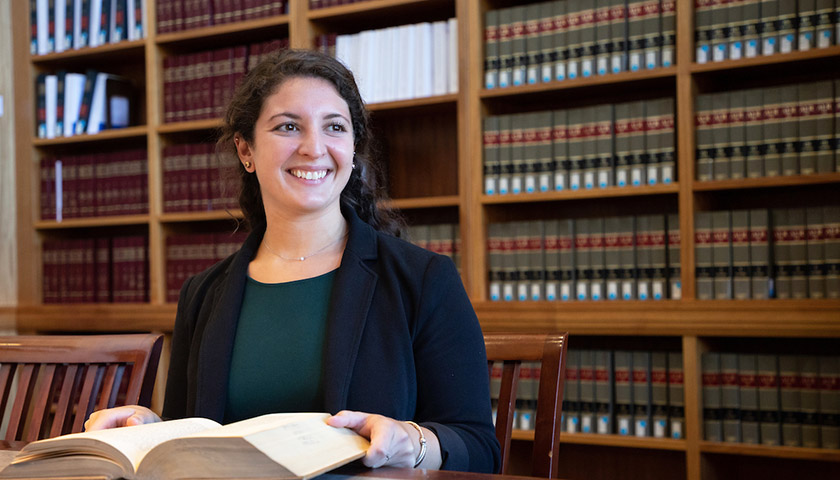While working in Suffolk’s Juvenile Defender Clinic, Nicole Siino JD’18 saw how difficult it was to quickly find her clients a spot in treatment or job programs before they were arraigned. Her student colleagues and public defenders shared the same concern—describing their frenzied attempts to find treatment spaces for their clients before the doors of the justice system closed.

Defense attorneys, especially when they’re handling low-level offenses like small-quantity drug possession and petty theft, often ask judges to divert their clients into social programs—from drug addiction treatment to group therapy—avoiding the scarlet letter of a criminal record.
They do that in part because the effects of a criminal record can be so far-reaching—ineligibility for college scholarships, lost opportunities for employment, and denials for private and public housing.
“I sat in court and listened to judges, attorneys, and probation officers talk about dozens of programs designed to help juveniles succeed,” Siino says, “and discovered that there was no master list of community-based resources. No place to go to do a comprehensive search where you could learn about programs and determine if they had openings.”
The idea that young people would lose an opportunity for professional help and a shot at redemption largely because lawyers and social workers didn’t have a basic web resource seemed wrong.
So she built one. And at this very moment, Massachusetts attorneys (and anyone else, for that matter) can check it on their phones from a courtroom.
A thousand reasons
There must have been a thousand reasons why Siino would never have undertaken such an effort: the academic grind of law school; potential bureaucratic hurdles among service-providers; lack of money and technical resources to maintain a web app after her graduation; and, one small hiccup—she didn’t know how to build a web app.
So, how did this happen? While she might have simply sent out an earnest tweet and moved on with her day, how did Siino create a juvenile treatment programs search tool? And how did she keep her project alive after graduation?
Learning to code
In her third year at Suffolk Law, Siino was taking two classes in the school’s Legal Innovation & Technology (LIT) Concentration—Lawyering in the Age of Smart Machines and 21st Century Lawyer—and also signed up to serve as a LIT Fellow in the school’s Juvenile Defenders Clinic. As part of the fellowship, where students sign on to make a process or tech improvement in a Suffolk clinic, she proposed to learn enough coding to begin working on her web app idea.
Teachers from her LIT classes taught her how to use Airtable, a cloud-based spread sheet and database tool into which she added information about community programs: locations, treatment options, and age range, among other items. David Colarusso, director of Suffolk’s LIT Lab helped her learn enough HTML and JavaScript to build a website and have it access Airtable.
She shared a rough draft of her app, which she dubbed Resource Finder, with clinic colleagues, attorneys, and social workers, who explained that the app needed filters for different kinds of programs: some juveniles needed counseling, others job training or substance abuse treatment, for example. And, the app needed a map pinpointing program locations, they said.
During a year-long stint in the ABA’s fledgling Next Gen Fellows program, Siino went back to the app, adding those capabilities and started to expand its reach to include cities outside of Boston and programs serving adults. She also collaborated with a current student in the LIT Lab and took in design input from students at Northeastern’s NuLaw Lab working on a similar project.
Asking the state to help
“One of the biggest challenges for students’ access to justice tech projects is how do you keep the project running after you finish school?” Siino says. Students have built apps that assist with parenting plans after divorce, health care proxies, and demand letters to landlords, among many others.
In 2019, after watching Siino’s presentation about the Resource Finder at Suffolk’s LITCon—the school’s gathering for people interested in mashing up technology and access to justice—a leader at the state’s Public Defenders Office showed interest in helping to keep the app’s program information up to date and increasing its reach beyond Boston. The defenders office is working with the LITLab on a formal agreement.
“I convinced CPCS [the Public Defender Agency of Massachusetts] that the app could easily be expanded to all of Massachusetts by simply adding resources outside of Boston into the Airtable,” she says. “I’d already created the technical backend.”
There was one more significant hurdle: What if there was a technical glitch with the Resource Finder? Siino wasn’t interested in saddling the state’s IT team with upkeep for an unsupported service, so she began looking for someone who could help with support.
Sometimes, it turns out, you just have to ask
In 2018, Siino met Darrel Malone at a Suffolk LIT Lab access to justice hackathon. Malone, an advanced coder and founder of the Tubman Project, was judging at the hackathon and partnering with the LIT Lab on open-source artificial intelligence tools designed to make legal help less expensive and easier to access. He agreed to have Tubman step in to provide support on the technical side.
“If you think about the impact of avoiding a criminal record, it’s monumental,” says Suffolk’s Colarusso, “Nicole was willing to take a creative approach, learn a new skill, and never gave up along the way.”
Siino is a consultant at Fireman & Company, a legal industry-focused management consulting firm.



